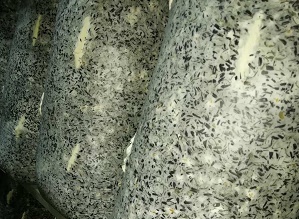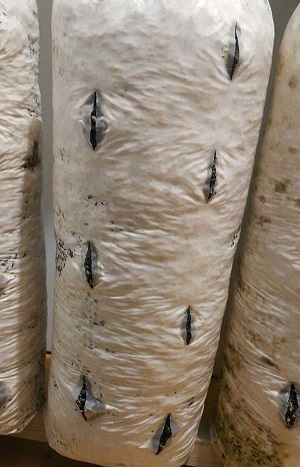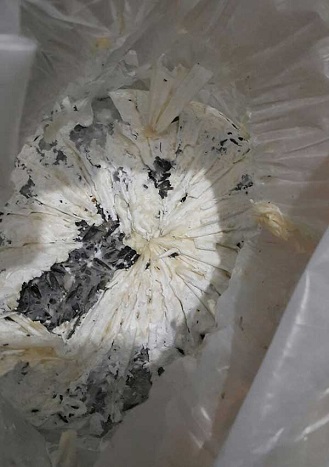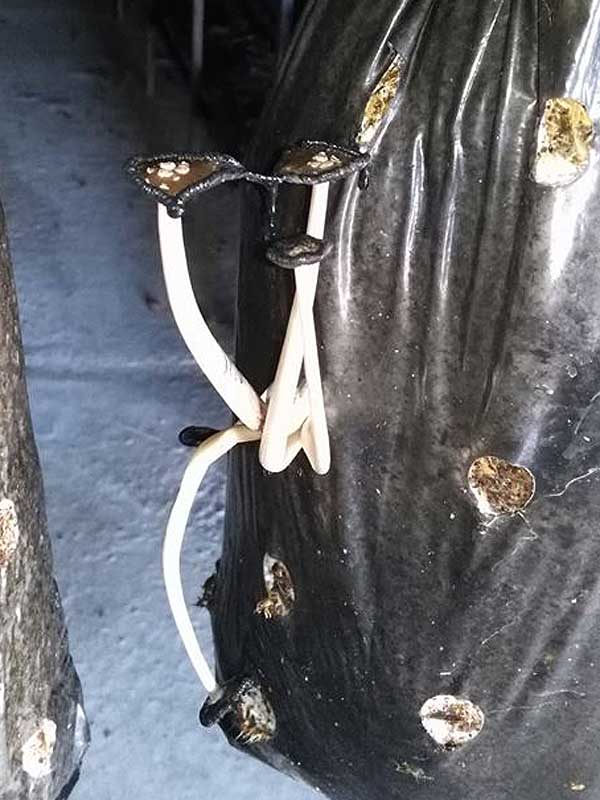There are several reasons why the mycelium itself does not grow into the substrate, and even if the mycelium occupies the block, pins do not arise.
The content of the article:
Here are the main reasons:

If several causes act simultaneously, oyster mushrooms may appear after the elimination of some of them.
Be sure to check that the microclimate in your growing room is suitable for growing this strain.
The most common reason for the lack of mushrooms is failure to maintain the recommended temperature and humidity.
For example, if the humidity in the growing chamber is low, the slots may dry out.
The mycelium in them dies from lack of moisture and, of course, primordia do not grow.
I want to emphasize that we are talking about a really WELL overgrown block. Below is a photo of an oyster mushroom block with stroma.
Obviously, the mycelium does not look healthy.
You see a photo of a live healthy mushroom block on the right.
Something white in a mushroom bag could be the stroma. You may have thought that this white fluff was white mold. However, the mushroom stroma is a formation from mycelium.
Stroma is a thick layer of mycelium hyphae that grows between the film and the substrate, protecting the block from high temperature and low humidity.
Many people think that if bags of oyster mushrooms are dense white, it means they are well overgrown.
But, if a gelatinous slimy mass gives the white color to the substrate (left) or there is a dry formation of white color in the form of crusts between the film and the substrate (right) - this is a stroma ↓.


Video - What is the white stuff in the mycelium?
Why mushroom grow bag not fruiting and there are no mushrooms on a well-grown block?
Often (especially in the warm season) an overgrown oyster mushroom block does not bear fruit due to an incorrect transition from the incubation mode to the fruiting mode.
You can check it like this:
We measure the temperature of the center of the block - T3 and under the film (between the film and the substrate) - T2.
The air temperature T1 is measured not far (10-15 cm) from the selected block. This is a must!
If T1 has been stable for a long time, and the temperature of the subfilm layer T2 is higher than the arithmetic mean of the center T3 and air T1, then the primordia will come out with a delay or not come out at all.
Example:
T1 = 23
T2 = 26
T3 = 28
Arithmetic mean = (23+28)/2 = 25.5
In this example, the temperature of the underfilm layer is higher, and it is necessary to start gradually reducing the temperature in the chamber to stimulate fruiting.
I know that many mushroom growers do not want to remember the mathematics and delve into this formula. They believe it's better to simply lower the room temperature with air conditioning, or even stick the blocks in the refrigerator if there are only a few of them.
However, no one is currently producing strains that require temperature shock. You don't need to lower the temperature suddenly.
But, if you do not check the arithmetic mean using the formula above, it may turn out that the reason for the absence of mushrooms is completely different. And you will only waste electricity running the cooler or air conditioner.
After fruiting begins, it is necessary to carefully observe the microclimate parameters in the growing room, since the marketability of the mushroom depends on this.
Another reason why mushrooms do not form on the block is that straw or sunflowers in the fields have been treated with fungicides or herbicides.
When using such raw materials, the growth of oyster mushroom mycelium is inhibited by these preparations, and the mycelium cannot bear fruit or the yield drops sharply.
It is not possible to determine whether there are fungicides in the husk or straw by external signs. A very large percentage of cereal and sunflower fields are treated with fungicides in years when there is continuous rain before and during harvest.
The amount of drug activity decreases to an acceptable level after 4-6 months. Therefore, problems with such raw materials occur in autumn and early winter.
Then the drug is inactivated and the yield can increase on the same straw or husk.
Read: Why primordia turn yellow and dry.
 This grebe, which is shown in the photo, is a coprinus. It is they who most often grow instead of oyster mushrooms. Such a mushroom bag will not bear fruit.
This grebe, which is shown in the photo, is a coprinus. It is they who most often grow instead of oyster mushrooms. Such a mushroom bag will not bear fruit.
There are several types of them, outwardly they look alike, with thin stems, a young hat looks like a bell.
Only the color of the hat is different: for some, it is white at first, and then darkens, turns gray or blackens, and for some it is immediately gray. As it matures, the hat spreads out, turns black and, if the type of coprinus is called "ink", it smears the hands.
Some types of koprinus are conditionally edible, but I do not recommend eating them, since you are unlikely to be able to accurately determine its type.
The appearance of foreign species of fungi on mushroom blocks indicates poor-quality processing of the substrate at low temperatures and insufficient heat treatment time.
Coprinus can signal that there is a lot of nitrogen in the substrate. But in combination with poor-quality steaming, this does not benefit oyster mushrooms.
Koprinus is especially common when preparing a substrate at home from straw, when, without preliminary soaking the raw materials, mushroom growers pour boiling water or hot water over the straw.
Video about coprinus
